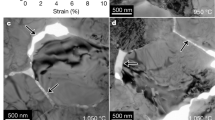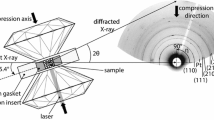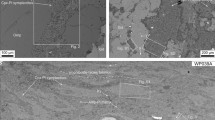Abstract
Creep strength of oriented orthopyroxene single crystals was investigated via shear deformation experiments under lithospheric conditions [P (pressure) = 1.3 GPa and T (temperature) = 973–1,373 K]. For the A-orientation (shear direction [001] on (100) plane), the samples have transformed completely to clinoenstatite and much of the deformation occurred after transformation. In contrast, for the B-orientation (shear direction [001] on (010) plane), samples remained orthoenstatite and deformation occurred through dislocation motion in orthoenstatite. The strength of orthopyroxene with these orientations is smaller than for olivine aggregates under all experimental conditions. Flow of the B-orientation samples is described by a power-law, and the pre-exponential constant, the apparent activation energy, and the stress exponent are determined to be A = 10−9.5 s−1·MPa−4.2, Q = 114 kJ/mol and n = 4.2. However, for the A-orientation, the results cannot be fit by a single flow law and we obtained the following: A = 108.9 s−1·MPa−3.0, Q = 459 kJ/mol and n = 3.0 at high temperatures (≥1,173 K), and A = 10−27.4 s−1·MPa−14.3, Q = 296 kJ/mol and n = 14.3 at low temperatures (<1,173 K). The stress exponent for the low-temperature regime is high, suggesting that deformation involves some processes where the activation energy decreases with stress such as the Peierls mechanism. Our study shows that orthopyroxene with these orientations is significantly weaker than olivine under the lithospheric conditions suggesting that orthopyroxene may reduce the strength of the lithosphere, although the extent to which orthopyroxene weakens the lithosphere depends on its orientation and connectivity.














Similar content being viewed by others
References
Anastasiou P, Seifert F (1972) Solid solubility of Al2O3 in enstatite at high temperatures and 1–5 kb water pressure. Contrib Mineral Petrol 34:272–287
Bai Q, Mackwell SJ, Kohlstedt DL (1991) High-temperature creep of olivine single crystals 1. Mechanical results for buffered samples. J Geophys Res 96:2441–2463
Balachandar S, Yuen D, Reuteler D (1995) Localization of toroidal motion and shear heating in 3-d high Rayleigh number convection with temperature-dependent viscosity. Geophys Res Lett 22:477–480
Bercovici D (2003) The generation of plate tectonics from mantle convection. Earth Planet Sci Lett 205:107–121
Boullier AM, Gueguen Y (1975) SP-mylonites: Origin of some mylonites by superplastic flow. Contrib Mineral Petrol 50:93–104
Braun J, Chery J, Poliakov A, Mainprice D, Vauchez A, Tomassi A, Daignieres M (1999) A simple parameterization of strain localization in the ductile regime due to grain size reduction: a case study for olivine. J Geophys Res 104:25167–25181
Bystricky M, Mackwell S (2001) Creep of dry clinopyroxene aggregates. J Geophys Res 106:13443–13454
Carter JL (1970) Mineralogy and chemistry of the Earth’s upper mantle based on the partial fusion–partial crystallization model. Bull Geol Soc Am 81:2021–2034
Chopra PN, Paterson MS (1981) The experimental deformation of dunite. Tectonophysics 78:453–473
Coe RS, Kirby SH (1975) The orthoenstatite to clinoenstatite transformation by shearing and reversion by annealing: mechanism and potential applications. Contrib Mineral Petrol 52:29–55
Demouchy S, Schneider SE, Mackwell SJ, Zimmerman ME, Kohlstedt DL (2009) Experimental deformation of olivine single crystals at lithospheric temperatures. Geophys Res Lett 36:L04304. doi:10.1029/2008GL036611
Durham WB, Goetze C (1977) Plastic flow of oriented single crystal of olivine, 1, mechanical data. J Geophys Res 82:5737–5753
Evans B, Goetze C (1979) The temperature variation of hardness of olivine and its implication for polycrystalline yield stress. J Geophys Res 84:5505–5524
Frost HJ, Ashby MF (1982) Deformation-mechanism maps: the plasticity and creep of metals and ceramics. Pergamon, New York, 167 pp
Gleason GC, Tullis J (1993) Improving flow laws and piezometers for quartz and feldspar aggregates. Geophys Res Lett 20:2111–2114
Goetze C (1975) Sheared lherzolites: from the point of view of rock mechanics. Geology 3:172–173
Hiraga T, Tachibana C, Ohashi N, Sano S (2010) Grain growth systematics for forsterite ± enstatite aggregates: effect of lithology on grain size in the upper mantle. Earth Planet Sci Lett 291:10–20
Hitchings RS, Paterson MS, Bitmead J (1989) Effects of iron and magnetite additions in olivine-pyroxene rheology. Phys Earth Planet Sci 55:277–291
Ingrin J, Skogby H (2000) Hydrogen in nominally anhydrous upper-mantle minerals: concentration levels and implications. Eur J Mineral 12:543–570
Jung H, Karato S (2001) Effects of water on dynamically recrystallized grain-size of olivine. J Struct Geol 23:1337–1344
Karato S, Jung H (2003) Effects of pressure on high-temperature dislocation creep in olivine. Philos Mag A83:401–414
Karato S, Lee K-H (1999) Stress and strain distribution in deformed olivine aggregates: inference from microstructural observations and implications for texture development. In: Szpunar JA (ed) Proceedings of the twelfth international conference on textures of materials, ITOCOM-12, vol 2. pp 1546–1555
Karato S, Paterson MS, Fitz Gerald JD (1986) Rheology of synthetic olivine aggregates: influence of water and grain size. J Geophys Res 91:8151–8176
Karato S, Jung H, Katayama I, Skemer P (2008) Geodynamic significance of seismic anisotropy of the upper mantle: new insights from laboratory studies. Annu Rev Earth Planet Sci 36:59–95
Keppler H, Bolfan-Casanova N (2006) Thermodynamics of water solubility and partitioning. Rev Mineral Geochem 62:193–230
Kocks WF, Argon AS, Ashby MF (1975) Thermodynamics and kinetics of slip. Prog Mater Sci 19:1–291
Kohlstedt DL, Goetze C, Durham WB (1976) Experimental deformation of single crystal olivine with application to flow in the mantle. In: Strens RGJ (ed) The physics and chemistry of minerals and rocks. Wiley, New York, pp 35–49
Kohlstedt DL, Nichols HPK, Hornack P (1980) The effect of pressure on the rate of dislocation recovery in olivine. J Geophys Res 88:3122–3130
Kohlstedt DL, Evans B, Mackwell S (1995) Strength of the lithosphere: constraints imposed by laboratory experiments. J Geophys Res 100:17587–17602
Kollé JJ, Blacic JD (1983) Deformation of single-crystal clinopyroxenes: 2. Dislocation-controlled flow processes in hedenbergite. J Geophys Res 88:2381–2393
Korenaga J (2007) Thermal cracking and the deep hydration of oceanic lithosphere: a key to the generation of plate tectonics? J Geophys Res 112:B05408. doi:10.1029/2006JB004502
Mackwell SJ (1991) High-temperature rheology of enstatite: implications for creep in the mantle. Geophys Res Lett 18:2027–2030
Mirwald PW, Getting IC, Kennedy GC (1975) Low-friction cell for piston-cylinder high-pressure apparatus. J Geophys Res 80:1519–1525
Mitchell TE, Thornton PR (1963) Work-hardening characteristics of Cu and alpha-brass single crystals between 4.2 and 500 degrees K. Philos Mag 8:1127–1159
Ohuchi T, Nakamura M (2007) Grain growth in the forsterite–diopside system. Phys Earth Planet Inter 160:1–21
Paterson MS (1982) The determination of hydroxyl by infrared absorption in quartz, silicate glasses and similar materials. Bull Minéral 105:20–29
Phakey P, Dollinger G, Christie J (1972) Transmission electron microscopy of experimentally deformed olivine crystals. In: Heard HC et al (eds) Flow and fracture of rocks: the Griggs volume, Geophysical Monograph Series, vol 16. AGU, Washington, DC, pp 117–138
Raleigh CB, Kirby SH, Carter NL, Ave’ Lallemant HG (1971) Slip and the clinoenstatite transformation as competing rate processes in enstatite. J Geophys Res 76:4011–4022
Richards MA, Yang W-S, Baumgardner JR, Bunge H-P (2001) Role of a low-viscosity zone in stabilizing plate tectonics: Implications for comparative terrestrial planetology. Geochem Geophys Geosyst 2. doi:10.1029/2000GC000115
Ross JV, Nielsen KC (1978) High-temperature flow of wet polycrystalline enstatite. Tectonophysics 44:233–261
Rybacki E, Renner J, Konrad K, Harbott W, Rummel F, Stöckhert B (1998) A servohydraulically-controlled deformation apparatus for rock deformation under conditions of ultra-high pressure metamorphism. Pure Appl Geophys 152:579–606
Seeger A (1957) Dislocations and mechanical properties of crystals (ed. Fisher JC), 243 pp. Wiley, New York
Skemer P, Karato S (2008) Sheared lherzolite xenoliths revisited. J Geophys Res 113:B07205. doi:10.1029/2007JB005286
Skrotzki W, Wedel A, Weber K, Müller WF (1990) Microstructure and texture in lherzolites of the Balmuccia massif and their significance regarding the thermomechanical history. Tectonophysics 179:227–251
Smith BK, Carpenter FO (1987) Transient creep in orthosilicates. Phys Earth Planet Sci 49:314–324
Solomatov VS, Moresi L (1997) Stagnant lid convection on venus. J Geophys Res 101:4737–4753
Suhr G (1993) Evaluation of upper mantle microstructures in the Table Mountain massif (Bay of Islands ophiolite). J Struct Geol 15:1273–1292
Tackley PJ (2000) Self-consistent generation of tectonic plates in time-dependent, three-dimensional mantle convection simulations 2. Strain weakening and asthenosphere. Geochem Geophys Geosyst 1. doi:10.1029/2000GC000043
Turcotte DL, Schubert G (1982) Geodynamics: applications of continuum physics to geological problems, 450 pp. Wiley, New York
Warren JM, Hirth G (2006) Grain size sensitive deformation mechanisms in naturally deformed peridotites. Earth Planet Sci Lett 248:438–450
Zhang J, Green HW (2007) Experimental investigation of eclogite rheology and its fabrics at high temperature and pressure. J Metamorphic Geol 25:97–115
Acknowledgments
We thank J. Korenaga and D. Spengler for discussion and Z. Jiang for technical assistance. Official review by two anonymous reviewers improved the manuscript. This study was supported by a research fellowship from Japan Society for the Promotion of Science (to T. Ohuchi), US National Science Foundation grants (to S. Karato), and the Global COE program of Ehime University.
Author information
Authors and Affiliations
Corresponding author
Additional information
Communicated by H. Keppler.
Rights and permissions
About this article
Cite this article
Ohuchi, T., Karato, Si. & Fujino, K. Strength of single-crystal orthopyroxene under lithospheric conditions. Contrib Mineral Petrol 161, 961–975 (2011). https://doi.org/10.1007/s00410-010-0574-3
Received:
Accepted:
Published:
Issue Date:
DOI: https://doi.org/10.1007/s00410-010-0574-3




